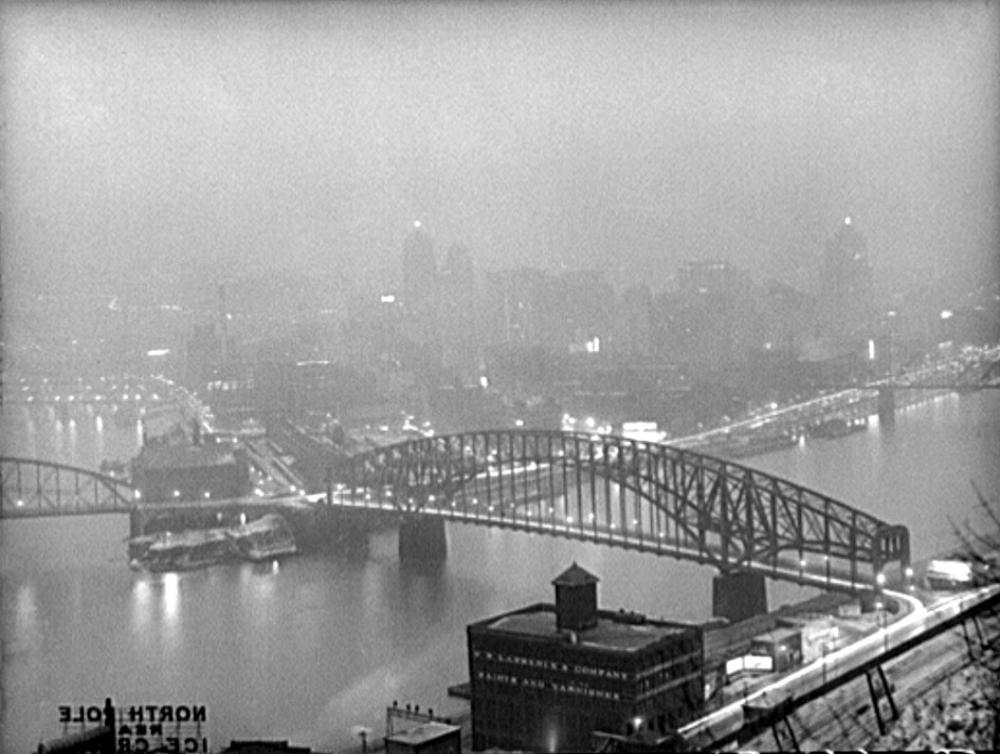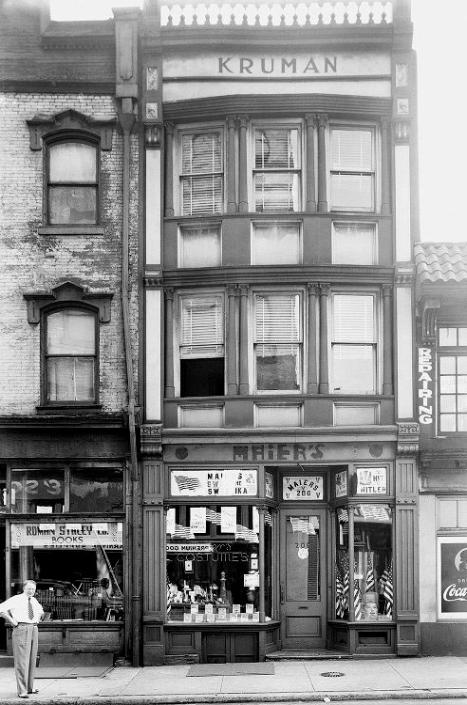| All rights reserved. |
| Pittsburgh 1940's |
| Corner of Liberty and Fifth Avenues at 8:38 AM |
| ALL THINGS PITTSBURGH |
| By the 1940's, Pittsburgh was dark at all hours of the day. Photographs of the past show dark downtown streets lined with bright streetlamps at ten in the morning. The city was reaching a breaking point. David L. Lawrence became mayor in 1946 and promised he’d beautify and clean up the city. In his first inaugural speech, Lawrence said, “I am convinced that our people want clean air. There is no other single thing which will so dramatically improve the appearance, the health, the pride, the spirit of the city.” Lawrence felt passionate about cleaning up the city since he had grown up in a tough working-class Irish neighborhood in the Point by Fort Pitt. The neighborhood consisted of many run-down and abandoned steel mills and other old industrial buildings. He had lived among some of the worst impurities in the city and saw the need to improve conditions. After becoming mayor, he began what has been referred to as “Renaissance I” to clean up the city. But before that could happen...We had a WAR to win! |
| An Invaluable Relationship Begins... Steelworker & Sailor |
| After shaking off the doldrums of the Great Depression, the 1940's ushered in another colossal challenge that would test every man, woman & child in this country, World War! After the sneak attack at Pearl Harbor and the expansionism of the fascists in Germany, it was time for this great country to explode into action and no one city better exemplified an explosion of action than Pittsburgh. Pittsburgh would be the determining factor as to if we won this war or not. As the United States was gearing up its industrial might to prepare the nation for war, Pennsylvania Governor Arthur James, paraphrasing one of president Franklin Delano Roosevelt's better-known quips, proudly boasted that the Keystone State would become the "Arsenal of America." And indeed, the Commonwealth's industries helped ensure Allied victory in World War II. Pennsylvania's key geographical position–the "Keystone State" nickname was aptly earned during the Revolutionary War–ensured that the important role that the state would play in the nation's war effort. But it was the smoky little town in the western confines of the state that would rise up and become the behemoth that would swat down both Japanese Imperialism and Nazi Germany's Fascism. |
| Pittsburgh's industrial potential, which had begun to emerge from the throes of the Depression as a result of government financing of war-related industries, helped place the city in the forefront of the nation's burgeoning military-industrial might. Pittsburgh was a major producer of both anthracite and bituminous coal. Pittsburgh's legendary steel industry was supplemented by the vast holdings of Bethlehem Steel, led by Eugene Grace. Harrisburg Community Chest and War Fund flyer which reads, Give once and for all. Win the War sooner. Double last years gift. On the Home front, on the Fighting front, on the Allied front. |
| During the course of World War II, Pittsburgh supplied 31 percent of America's steel and 20 percent of worldwide production, a phenomenal accomplishment. The city was also the country's leading supplier of Portland cement. Though the state's oil production had declined–it had led the nation into the early 1900s–Pennsylvania produced the nation's highest quality of vital lubricating oil and its refineries churned out millions of gallons of 100-octane gasoline, a necessity for modern aircraft engines. Agricultural production also rose, as farmers pitched in to help the war effort. The totality of the war effort needed to fight a global conflict affected every Pennsylvanian. The federal government rationed meat, sugar, gasoline, rubber tires, coffee, and other vital products, and the war effort drastically cut into items most consumers could previously buy. The war cost lots of money–billions and billions of dollars–that the federal government asked the people to help fund by purchasing government bonds that would mature ten years after the date of issue. After the first war bond drive started on May 1, 1941, the government saturated the country with bond sales advertising and enlisted hundreds of celebrities to help convince Americans to buy bonds. From then until the end of the last drive on January 3, 1946, the American people bought $185.7 billion in government bonds. The federal government raised 46 percent of its money for the war effort with taxes; the remaining 54 percent came through borrowing, and most of that through the bond sales. |
| View of attendees at a World War II memorial service held at the Pittsburgh and Lake Erie Railroad McKees Rocks yards. |
| Bond Rally at the Homestead Steel Works Behind the men are a series of propaganda posters encouraging continued resolve in the war effort. The victory legion banner at the top illustrates the real correlation between lost time and reduced production. High production was seen as a patriotic duty in light of booming war demands. The United States Steel Corporation produced over one third of America's total steel output during the war. |
| Market Street looking east at Maier's Store with American Flags and World War II Propaganda in the Windows. |
| PITTSBURGH IN 1942 |
| East Pittsburgh Westinghouse Plant Workers at a Rally for Full Production During World War II. |










